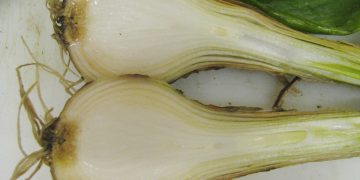FightingFusarium #OnionCrops #IPM #Fungus #CropRotation #SoilSterilization
Fusarium basal rot, caused by the fungus Fusarium oxysporum f. sp. cepae, is a serious disease affecting onion crops worldwide. This disease attacks the roots and basal plate of the onion, causing wilting and eventually killing the plant. Fusarium basal rot can be difficult to detect, and once it infects a field, it can persist in the soil for many years, making it a significant threat to onion production.
The development of Fusarium basal rot is influenced by several factors, including temperature, soil moisture, and soil pH. The fungus can survive in soil or plant debris for extended periods and can spread through infected soil, plant material, and even contaminated equipment. The disease can also be introduced into fields through infected seed.
Consequences of Fusarium basal rot include reduced onion yields and quality, increased production costs, and potential market losses. The use of chemical fungicides can help manage the disease, but it is not always effective, and there is a risk of fungicide resistance developing over time.
To combat Fusarium basal rot, integrated pest management (IPM) strategies are recommended, including the use of resistant onion cultivars, crop rotation, and soil sterilization. Farmers should also practice good sanitation measures to prevent the spread of the disease and carefully monitor their crops for symptoms.
In conclusion, Fusarium basal rot is a significant threat to onion production, but with proper management practices, it can be controlled. By understanding the factors that influence the development of the disease and implementing effective IPM strategies, farmers can reduce the impact of Fusarium basal rot on their crops.































